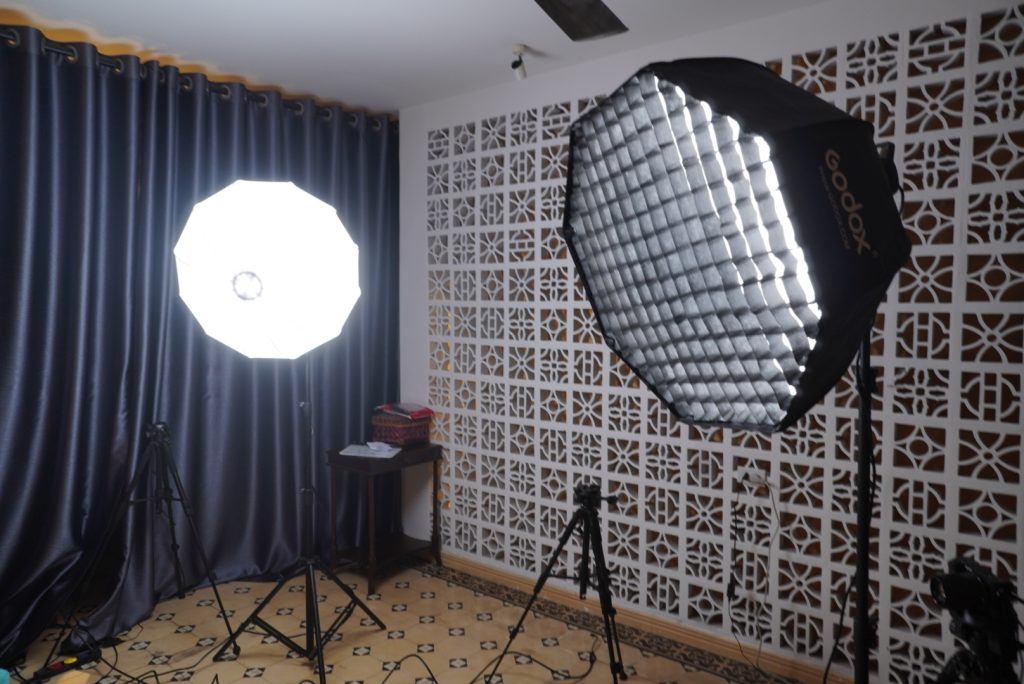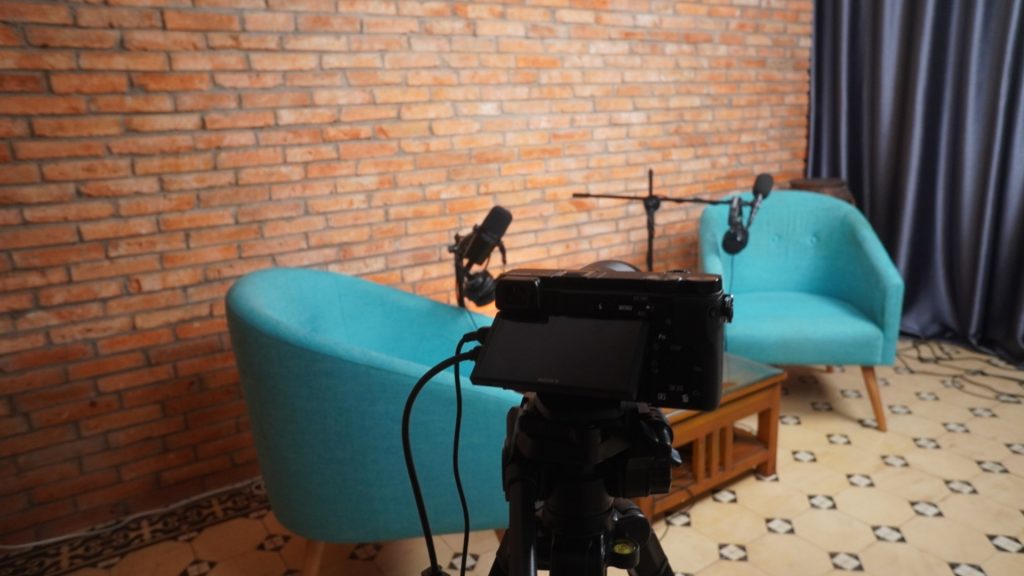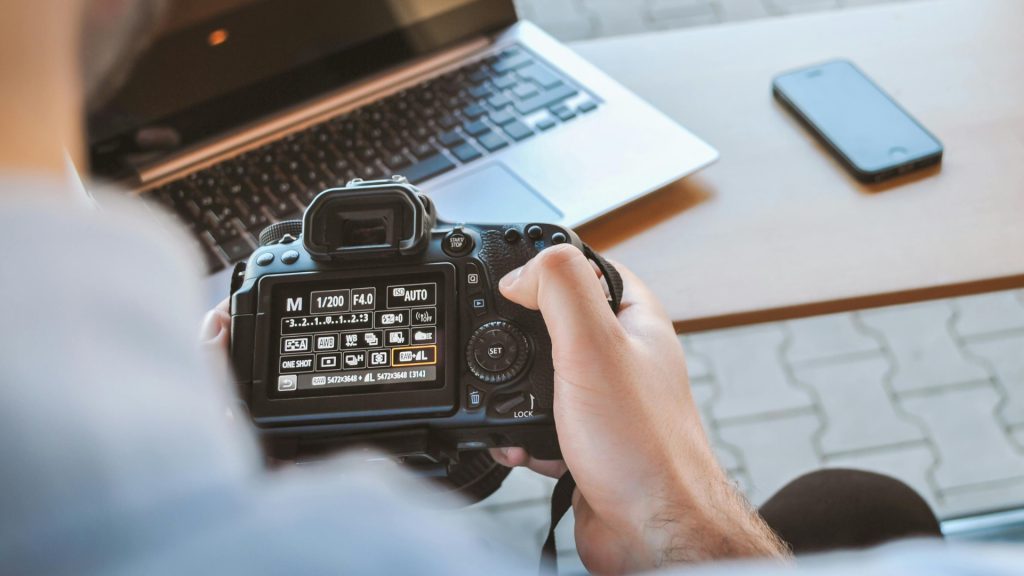Video podcasting is more popular than ever, and with platforms like YouTube and Spotify Video, camera quality can make a big difference in how your content is perceived.
Whether you’re filming at home or in a podcast studio, understanding the right camera settings for podcast recording is key to achieving a professional look.
Let’s see what you need to consider when setting up your camera.
Table of Contents
ISO – Brightness Without the Noise
When it comes to podcast camera settings, ISO is one of the first things to understand. Whether you’re filming in your living room or renting a podcast studio in Saigon, getting ISO right can make the difference between a clean, professional-looking video and a grainy mess.
A clean ISO setting makes your skin tones look better and avoids that soft, fuzzy video quality that turns viewers away.
What is ISO?
ISO controls your camera’s sensitivity to light:
- Low ISO (100–400): darker image, but cleaner and sharper
- High ISO (800+): brighter image, but with more noise or grain
In most podcast recording setups, you’re indoors with controlled lighting, so there’s no need to crank up the ISO.
Best ISO Settings for Podcast Recording
To get the best results:
- Start with ISO 100 or 200 if you’re using good studio lighting
- Stay under ISO 800 to avoid digital noise
- Manual mode is key – don’t let your ISO jump around automatically during recording
- If you’re using a video podcast studio, lighting should be optimized to keep ISO low
Studio Tip: Let Light Do the Work

In professional podcast studios in Ho Chi Minh, we use:
- Softbox lights
- LED panels with adjustable color temperature
- Diffusers to eliminate harsh shadows
This allows us to record at low ISO settings, resulting in sharp, noise-free footage—perfect for YouTube or any other video podcast platform
White Balance – Natural Skin Tones, No Weird Tints
One of the most overlooked settings in video podcast camera setup is white balance, and it’s the reason why some podcasts look natural while others seem like they were shot on Mars.
What is White Balance?
White balance tells your camera how to interpret the color of light. Different light sources give off different color temperatures:
- Daylight: ~5500K (cooler/blue tone)
- Tungsten bulbs: ~3200K (warmer/orange tone)
If you don’t set it manually, your video can look too orange, blue, or even green, especially when your lights and environment aren’t consistent.
Why White Balance Matters for Podcasters
- Keeps skin tones natural
When white balance is off, your skin might look too orange, pale, or even green. A well-balanced image helps your guests look their best—clean, natural, and camera-ready—no matter their skin tone.
- Avoids color shifts during recording
If you’re using auto white balance, your camera may try to adjust colors constantly as lighting changes slightly (like a guest moving or a phone screen lighting up).
- Ensures a consistent, professional look across all podcast episodes
Whether you’re publishing to YouTube, Spotify Video, or Instagram, consistency matters. If each episode has a different color tone, your brand image can feel disjointed.
- Prevents “auto color correction” from ruining your footage mid-shoot
Auto camera settings may react unexpectedly to reflective surfaces (like glasses, tablets, or light-colored clothes), causing sudden color temperature changes.

Best White Balance Settings for Podcast Recording
To nail your podcast video camera settings, follow these tips:
- Use manual white balance – skip the “auto” mode
- Match the setting to your lights:
- Use a white or gray card before shooting to calibrate perfectly
- Once you lock it in, your color temperature won’t shift during the episode
Frame Rate – Smooth Motion for a Professional Look
One of the most important camera settings for podcast recording is frame rate, especially if you’re planning to upload your podcast to platforms like YouTube or TikTok.
Frame rate refers to how many frames per second (fps) your camera records. The higher the number, the smoother the motion. But smoother isn’t always better for podcasts.
Best Frame Rates for Podcast Video
24fps:
- Gives your video a “cinematic” look
- Often used in documentaries and storytelling formats
30fps:
- Feels more like real-life motion
- Ideal for talking-head podcasts, interviews, and vlogs
60fps:
- Looks ultra-smooth but can feel unnatural for podcast content
- Best used for slow-motion effects or high-motion scenes—not typical in a podcast studio

At our podcast studio in Saigon, we help clients choose the right frame rate based on their content type and where they plan to publish, so they can focus on recording, not technical camera settings.
Resolution – Full HD or 4K?
In simple terms, resolution refers to how many pixels your camera captures. The higher the resolution, the more detail in your video.
When deciding on the best resolution for podcast recording, many podcasters wonder: Should I go with Full HD, or is 4K really necessary? While 4K is often associated with high-end production, it’s not always the most practical option, especially for long-form video content like podcasts.
Full HD (1080p):
- Totally acceptable for video podcast content
- Smaller file sizes, faster to edit
- Widely supported by social platforms like YouTube, Spotify Video, and Facebook
4K:
- Ideal for high-end production
- Let you crop, zoom, or reframe in post-production without losing quality
- Require more storage and processing power
At our podcast studio in Saigon, we offer 4K recording with professional lighting and camera setups—perfect for podcasters who want the option to zoom, crop, or repurpose clips for social media without sacrificing quality. If your current gear or editing setup can’t handle 4K, don’t worry.
Conclusion – Best Camera Settings For Podcast
You don’t need the most expensive gear to create high-quality podcast videos—just the right settings. By adjusting your ISO, white balance, frame rate, and resolution, you’ll produce cleaner, more polished content that looks great across all platforms.
And if you want to skip the setup and focus on your message, our podcast studio in Ho Chi Minh City is ready with 4K recording, pro lighting, and everything you need to create standout video podcasts. Ready to hit record? Book your session today.
Vietnamese Version
Cài Đặt Camera Chuẩn Cho Video Podcast: Bí Quyết Quay Podcast Chuyên Nghiệp Ở Sài Gòn
Video podcast đang phát triển mạnh mẽ hơn bao giờ hết. Với các nền tảng như YouTube và Spotify Video, chất lượng hình ảnh giờ đây có thể tạo nên hoặc phá hủy ấn tượng của người xem về chương trình của bạn.
Dù bạn đang quay podcast ở nhà hay thuê podcast studio ở Sài Gòn, việc hiểu và cài đặt đúng các thông số camera sẽ giúp video của bạn trông chuyên nghiệp, sáng rõ và thu hút hơn rất nhiều.
Hãy cùng xem những yếu tố quan trọng bạn cần biết khi cài đặt camera quay podcast.
ISO – Độ Sáng Rõ Nét, Không Nhiễu Hạt
Một trong những yếu tố quan trọng nhất khi quay podcast bằng camera là ISO.
Dù bạn quay ở phòng khách hay trong studio podcast ở HCM, việc điều chỉnh đúng ISO sẽ giúp video sáng rõ, không bị mờ hoặc “rỗ hạt”.
ISO là gì?
ISO điều khiển độ nhạy sáng của cảm biến máy ảnh:
- ISO thấp (100–400): hình tối hơn nhưng nét và sạch hơn
- ISO cao (800+): sáng hơn nhưng dễ xuất hiện nhiễu (noise, grain)
Vì hầu hết các buổi quay podcast ở Sài Gòn đều trong không gian có ánh sáng được kiểm soát, bạn không cần tăng ISO quá cao.
Cài đặt ISO tốt nhất khi quay podcast
- Bắt đầu với ISO 100–200 nếu có đèn studio tốt
- Giữ dưới ISO 800 để tránh nhiễu
- Luôn dùng chế độ manual (thủ công) – tránh để máy tự điều chỉnh ISO trong khi quay
- Nếu quay tại studio podcast chuyên nghiệp, ánh sáng thường được tối ưu để giữ ISO thấp và hình ảnh rõ nét
💡 Mẹo từ studio: Hãy để ánh sáng làm việc cho bạn.
Tại Saigon Podcast Studio, chúng tôi sử dụng:
- Đèn softbox ánh sáng mềm
- Đèn LED có thể chỉnh nhiệt độ màu
- Tấm tán sáng giúp loại bỏ bóng gắt
Nhờ đó, bạn có thể quay ở ISO thấp mà hình vẫn sáng rõ, mịn, và chuyên nghiệp — hoàn hảo cho YouTube hoặc Spotify Video.
White Balance – Giữ Màu Da Tự Nhiên, Không Ánh Lạ
Cân bằng trắng (white balance) là cài đặt nhiều người bỏ qua, nhưng lại ảnh hưởng lớn đến cảm nhận của người xem. Nếu sai, video có thể ngả xanh, vàng, hoặc cam quá mức — khiến gương mặt bạn trông “không thật”.
White balance là gì?
Mỗi nguồn sáng có nhiệt độ màu khác nhau:
- Ánh sáng ban ngày: khoảng 5500K (hơi xanh)
- Bóng đèn vàng (tungsten): khoảng 3200K (ấm, cam hơn)
Nếu để chế độ tự động, máy quay sẽ liên tục thay đổi màu sắc khi ánh sáng hoặc góc quay thay đổi — làm video thiếu ổn định.
Vì sao cân bằng trắng quan trọng khi quay podcast?
- Giúp màu da tự nhiên, đẹp mắt
- Giữ màu sắc ổn định suốt buổi thu, tránh bị ám xanh hoặc vàng
- Thống nhất phong cách hình ảnh giữa các tập podcast
- Tránh camera tự chỉnh màu đột ngột khi có ánh sáng phản chiếu từ điện thoại, kính, laptop,…
Cài đặt White Balance chuẩn cho video podcast
- Luôn tắt chế độ auto white balance
- Dùng chế độ thủ công (manual) và chọn nhiệt độ màu phù hợp với ánh sáng
- Sử dụng tấm trắng (white card) hoặc xám (gray card) để cân chỉnh trước khi quay
- Giữ nguyên thông số trong suốt buổi quay để đảm bảo sự đồng nhất
Frame Rate – Độ Mượt Của Chuyển Động
Frame rate (tốc độ khung hình) quyết định độ mượt của video, và là yếu tố quan trọng khi quay podcast để đăng YouTube, TikTok hoặc Spotify Video.
Frame rate là gì?
Frame rate cho biết máy quay ghi bao nhiêu khung hình mỗi giây (fps).
Càng nhiều khung hình, chuyển động càng mượt — nhưng không phải lúc nào “mượt” hơn cũng tốt hơn.
Gợi ý frame rate cho video podcast
- 24fps: Tạo cảm giác điện ảnh, phù hợp với podcast kể chuyện hoặc phỏng vấn sâu
- 30fps: Mượt tự nhiên, phù hợp nhất cho talking-head podcast, phỏng vấn, vlog
- 60fps: Rất mượt, nhưng hơi “ảo” cho nội dung podcast — chỉ nên dùng cho cảnh chuyển động nhanh hoặc slow motion
Tại Saigon Podcast Studio, chúng tôi giúp khách chọn đúng frame rate dựa vào phong cách nội dung và nền tảng đăng tải, để bạn chỉ cần tập trung nói — không phải lo phần kỹ thuật.
Resolution – Full HD Hay 4K?
Độ phân giải quyết định chi tiết và độ sắc nét của video.
Nhiều podcaster băn khoăn: nên quay Full HD (1080p) hay 4K?
Full HD (1080p)
- Đủ cho mọi nền tảng: YouTube, Spotify, Facebook
- File nhẹ, dễ chỉnh sửa và lưu trữ
- Phù hợp cho hầu hết podcaster cá nhân hoặc team nhỏ
4K
- Cho hình ảnh siêu sắc nét, chi tiết
- Có thể crop, zoom, hoặc cắt clip ngắn mà vẫn giữ chất lượng
- Cần dung lượng lớn và máy tính mạnh để xử lý
Tại studio podcast ở Sài Gòn của chúng tôi, bạn có thể chọn quay 4K với ánh sáng chuyên nghiệp – hoàn hảo nếu muốn xuất clip ngắn, reels, hoặc TikTok từ bản podcast chính mà vẫn giữ độ nét cao.
Nếu thiết bị hoặc phần mềm của bạn chưa hỗ trợ 4K, Full HD vẫn hoàn toàn đủ chuyên nghiệp.
Kết Luận – Cài Đặt Camera Chuẩn Cho Video Podcast
Bạn không cần máy quay đắt tiền để có podcast video chuyên nghiệp – chỉ cần hiểu và điều chỉnh đúng các thông số cơ bản: ISO, White Balance, Frame Rate và Resolution.
Chỉ vài bước tinh chỉnh, bạn sẽ có được hình ảnh sáng rõ, màu tự nhiên và chuyển động mượt mà – giúp podcast của bạn nổi bật giữa hàng ngàn video khác.
Nếu bạn muốn tập trung vào nội dung mà không phải lo setup kỹ thuật, hãy đến Saigon Podcast Studio – studio podcast ở HCM chuyên nghiệp với:
- Ghi hình 4K, ánh sáng chuẩn TV
- Âm thanh cách âm, trong trẻo
- Kỹ thuật viên hỗ trợ trọn buổi
- Gói quay – dựng – xuất bản hoàn chỉnh


